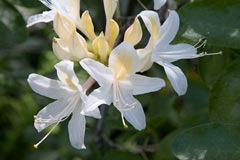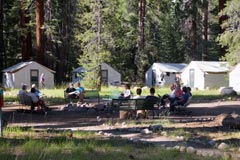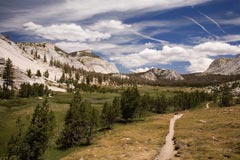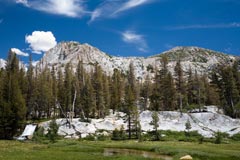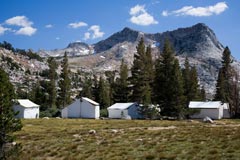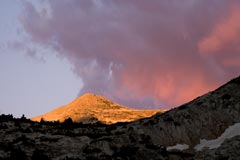
This long report serves three purposes: First, it provides general infomation regarding Yosemite's High Sierra Camps with sections on Background, Getting A Reservation, What to Bring, and Food. Second, it describes my six day trip including What I Learned for Next Time. Third, it lists Directions and GPS Coordinates of my route. Click on HscReport2009.pdf for a PDF copy of this report. You may want to view larger versions of the pictures, look at the slide show.
Yosemite's High Sierra Camps ~ 21-26 July 2009
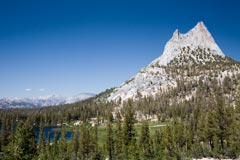
Cathedral Peak |
Background
Yosemite National Park, a place to enjoy Mother Nature's finest, is nearly in my backyard, so I was surprised to meet so many people from afar when I tramped its High Sierra Camps. Certainly a popular place, but once I got away from the roads the crowds thinned while the landscape morphed from stunning to stupendous. The High Sierra Camps are a way to visit some of the best of Yosemite while not having the burden and intricacies of backpacking. The camps comprise a set of five tent & breakfast & dinner locales which can be walked to with a light pack enjoying the landscape along the way and relaxing with other eclectic enthusiasts at night.
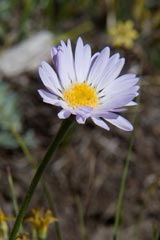
Wandering Daisy |
This was my first excursion to the High Sierra Camps. I started with a night at Tuolumne Meadows Lodge (8,775') to acclimatize, spent two nights at Sunrise Camp (9,400'), two nights at Merced Camp (7,150), one night at Vogelsang Camp (10,300'), and returned. There are two other camps which I did not visit: May Lake (9,270) and Glen Aulin (7,800') Camps.
Certainly two night stays at the Camps was delightful having a full day to explore nearby areas. My hoped for itinerary was two nights at each camp I visited, but reservations blunted me to one less night. Still a most enjoyable outing, but with only a very short stay at Vogelsang I must return to explore this fascinating area - maybe the best region of the High Sierra Camp system.
Of the days I was in the high country, the most enjoyable were the days tramping along Echo Creek from Sunrise to Merced Camps, and then along Fletcher Creek from Merced to Vogelsang Camps. Both of these areas had abundant spacious meadows with flourishing wildflowers within towering granite basins. Of course I enjoyed my extra days at Sunrise and Merced. Oddly after delighting in the interior, I was disappointed with the treks to/from Tuolumne Meadows, I thought this area pleasant but not nearly as special.
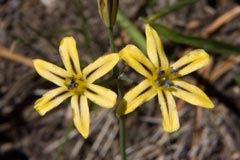
Pretty Face |
Getting A Reservation
Planning early for a trip to the High Sierra Camps is probably best, you can submit an application via the lottery typically before November. If so, then sometime around the middle of February you will be notified if you've been selected or not. Many of my friends have been consistently lucky with the lottery while others have not, and my first attempt I was not. But not being selected doesn't mean you're locked out. Many of the those selected decline their submissions which opens up space for others. So what I did was to leave a request of my preferred itinerary with the reservation center (usually starting April 1), and then they fill these requests on a first come first serve basis. My submission was answered in about 8 days, and I got five of six nights for the dates I requested.
What to Bring
| |
|
On the trail I wore nylon pants, silk long sleeve shirt (a great material that is cool in summer and never smells), underwear (of course), wool socks, knee support (ah, the honors of aging), sturdy hiking boots, and hat with large sun brim, and I carried a Swiss-army knife, a bandana, and a walking staff. In a medium-sized day-pack I carried a change of socks & underwear & silk long sleeve shirt, small towel, 2 extra bandanas (I often use a bandana as a wash cloth), nylon shirt, 100-weight fleece jacket, rain shell (didn't need), silk underwear (never used), wool cap (used while sleeping), light-weight fleece gloves (never used), first aid kit, headlamp, extra batteries, silk sleep sheet (a must as camps don't supply linens), and a ditty bag containing personal essentials such as toothbrush, toothpaste, dental floss, sun screen, bug repellant, camp soap, small bottle of hand sanitizer, iodine for water treatment, ear plugs (for sleeping in tent), etc. I typically carried 1-1/2 liters of water in a Platapus thru-the-straw drinking system while refilling it creek side along the way using iodine for treatment, I often drank 3 liters of water a day on the trail, and I carried a replacement bladder (just in case of a leak). I also carried an empty pint bottle which I filled and used at the camps for convenient water in the tent. I carried topo maps of everywhere I planned to be. My luxury items were a dime-store novel, sit pad, Garmin GPS (downloaded with maps), voice recorder, and about 10 pounds of camera gear (we all have are loves and pains). My pack weighed about 17 pounds with 1-1/2 liters of water and no camera gear. Many people also brought a pair of light-weight camp shoes, rather I used a pair of neoprene booties which are suitable for nasty creek crossings (not used).
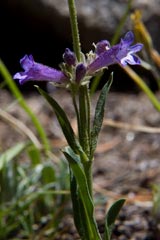
Sierra Penstemon |
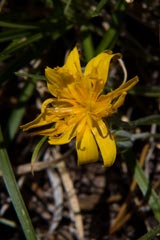
Pale Agoseris |
Food
Reservations at High Sierra Camps includes tent & breakfast & dinner, but not lunch. Meals were generally very good, sometime achieving a standing ovation award by patrons to staff. All meals were served family style and asking for more if still hungry was the rule but most always there was too much. The camps easily cater to vegetarians. Breakfasts I found most consistent comprising: Oatmeal, very fresh summer fruit, pancakes of the day (such a pumpkin, blueberry), omelet or scramble (such as black bean omelet), and breakfast meat (such as link sausage or bacon). Dinners at any camp on a specific day of the week were always the same so that a week's journey around the Camps provides different meals each night. On my Tuesday dinner was pasta (ravioli), Wednesday was salmon (baked), Thursday was pork (pulled served fajita style), Friday was chicken (baked), and Saturday was steak (served burrito style). Dinners always started with soup, very fresh mixed green salad (excellent), fresh bread, main coarse, fresh vegetable(s), and baked desert. My standing ovation dinners were salmon on Wednesday and chicken on Friday.
Sack lunches, ordered the night before, consisted of a sandwich, fruit (apple, orange), drink (apple juice or Gatorade), bag of trail mix, and cookies. Choice of sandwiches was limited such as turkey & cheese (processed American, ugh), ham & cheese, veggie, peanut butter & jelly, and similar, I always chose peanut butter & jelly. The cost of lunch was $15. Since I did not bring lunch material with me, I used this option, but I thought it much too expensive for the choices and quality. Next time I would do it myself, maybe buying a fruit along the way. I always recycled the paper lunch sack for the next day (waste not, want not).
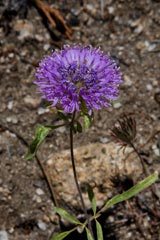
Mountain Pennyroyal |
Although I could have brought lunch and snacks along, I did not. However, these and any other aromatic items (sun screen, toothpaste, bug repellant, etc.) must be stored in the bear boxes at the camps rather than in tents. As a rule I always placed my aromatics in a bear box upon arriving at camp, then going slightly out of my way to retrieve the toothpaste (or what not) as needed.
The Drive Up, Monday, July 20
It was a lazy day, my goal was to reach Tuolumne Meadows by early afternoon to begin acclimatizing to the altitude. But along the way is an always favorite, an authentic Mexican food restaurant called Cocina Michoacana, located in Groveland. So I timed my departure to reach Groveland for lunch. I certainly didn't earn the lunch, just driving for 2-1/2 hours, but the meal, as always, met expectations - yummy, yummy. After lunch and a short 35 minute drive I was at the Big Oak entrance to Yosemite. The drive from the entrance to Tuolumne Meadows Lodge took another 1-1/2 hours.
After checking in I scouted the trail I would be starting on in the morning. It was a good exploration because there are so many local use trails around the Tuolumne Meadows area that I would have been frustrated in the morning trying to find the correct route. See the section on Directions & GPS Locations.
That evening I dined at Tuolumne Meadows Lodge. Oddly, the food here was not nearly as enjoyable as the High Sierra Camps even though there was a wide selection of main courses to choose from.
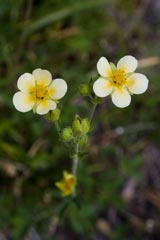
Nevada Cinquefoil |
Sunrise Camp via Cathedral Lakes, Tuesday, July 21
I got up for the first wave (7:30) of breakfast. The choices were continental buffet or full buffet, I chose the continental. Although it served its purpose, the meal was brutally disappointing. I had oatmeal (it was thin like soup), some fruit (tasted like winter stuff not like fresh summer), and a tasteless Danish. When I backpack, food is often more an energy necessity rather than an epicurean delight, so I just assumed that the next few days I would enjoy the out-of-doors, eat what was served, and return a few pound lighter. I learned otherwise.
At 9:00 I was ready to go, my car was parked 1/4 mile from the lodge near the Dog Lake trailhead. Although I had several options to tramp to Sunrise Camp, I chose what I now consider an unnecessary longer route (11 miles). I could have taken the free shuttle to the trailhead to Cathedral Lakes (8 miles) or to Tenaya Lake via Sunrise Lakes (6 miles).
At 9:17 I was at the first formal trail junction, marked as all official Yosemite junctions on steel plate. From here the sign indicated 10.9 miles to Sunrise Camp. I continued westbound past the nearby Elizabeth Lake trail junction (9:52), past the campground, and at 10:36 I reached the junction on the John Muir Trail to Cathedral Lakes (3.4 miles) and to Sunrise Camp (7.7 miles). The morning tramp was unspectacular as it passed through mostly dry pine forest and virtually nonexistent wildflowers. At 12:35 I reached the junction to lower Cathedral Lake and chose a visit for lunch reaching the lake at 12:54.
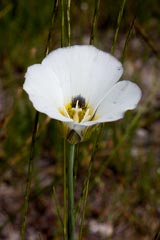
Mariposa Lily |
It was a pleasant stop. Lower Cathedral Lake was quite popular and I saw a few backpack groups around the lake. It was especially popular with day hikers. After a relaxing lunch and of course a time to play photographer I refilled my now empty water bottle for the second half of my first day.
By 2:17 I had again reached the Lower Cathedral Lake trail junction, another 4.5 miles to Sunrise Camp. I admired my superior planning as the temperature was a tolerable 80 degrees and as the days progressed I was treated with near perfect weather. Shortly thereafter (2:35) I reached Upper Cathedral Lake. It too was pleasant with similar granite and tree lined features, but it wasn't as peopled.
The highlight of the day (3:08) was the view at (9720') Cathedral Pass of Cathedral Peak (with it's twin spires) with Upper Cathedral Lake in the foreground. I stopped to enjoy the views, and then plodded on strolling down to Long Meadow.
At 4:25 I reached the junction to Merced Camp via Echo Creek, the route I would take two days later. I was still within Long Meadow, but now thankfully just 0.9 mile from Sunrise Camp. The meadow trail here skirts its western boundary, and as I lumbered on I noticed an unmarked junction in sight of a small wooden structure and sign, it was the path to Sunrise Camp. The side trail led to a cobblestone staircase to the Camp. At 4:45 I reached my home for the next two nights.
Sunrise Camp sits above the southern end of expansive Long Meadow. It has an eastern backdrop view of granite domes, a southern view of Mount Clark, and a western view of the Sunrise Mountains. The Camp accommodates 34 in tent cabins that mostly sleep 6. It has composting toilets and hot showers. Like all the Camps, there are steel bear lockers to store your aromatic items (such as food, toothpaste, sunscreen, etc.), I just made it a habit at Camp to always store aromatics in a bear locker even though it was sometimes inconvenient when personal chores were required.
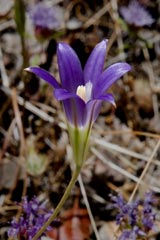
Elegant Brodiaea |
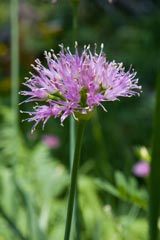
Pacific Mountain Onion |
Of course I reveled in a hot shower, an absolute wonderful luxury afforded by many (but not all) of the High Sierra Camps. I kicked back a few moments, then the dinner drink bell rang (as always at 6:00) where all congregated for tea or coffee or hot coco, and finally the formal dinner bell rang (as always at 6:30). My first Camp meal was not my favorite, but with it I learned myth from reality. Because the Tuolumne Meadows Lodge meals (dinner and breakfast), as I previously stated were disappointing, I assumed the same for the Camps. To my delight, dinner started with soup, then a wonderful fresh mixed green salad and fresh bread, then a main course of pasta with two kinds of ravioli, an assortment of fresh vegetables, and finally desert. Dinner was served family style at tables of about 8. Even though there was more than could be eaten, I could always ask for more. No one should ever go hungry at the Camps.
After dinner all congregated to enjoy the sunset near the ledge overlooking Long Meadow and the surrounding throng of granite. It was a pleasant sunset, but the next night proved more spectacular as evening clouds brought along hues of fiery red.
Sunrise Lakes, Wednesday, July 22
More often than not, my first night out is one of marginal sleep, and so it was. Of course my sleep wasn't aided by the exquisite snorer in my tent of 6. But fate was on my side, he and his friends moved on and I was blessed with quiet tent mates thereafter.
The breakfast drink bell rang (as always at 7:00) and shortly thereafter the main bell (as always at 7:30). Between dinner and breakfast, I found breakfast more consistent for my tastes. Breakfast, served family style, always started with oatmeal (prepared properly and with usual sides of raisons, brown sugar, milk, et. al.), then a bowl of very fresh summer fruit (ripe melons, blueberries, raspberries, strawberries), a platter of pancakes (e.g. pumpkin, blueberry) then a family sized omelet or scramble (e.g. black bean, veggie), and meat (e.g. link sausage, bacon) for carnivores. After breakfast (as always) I picked up a sack lunch that I ordered the night before.
| |
| |
|
One of the best features of extensive outdoor outings is the calories burnt. So I was not intimidated by the fact there was so much good food, I was always hungry and there was plenty to go around.
At 9:30 I was ready for my day's outing, a journey to the three Sunrise Lakes and of course to play photographer. I had heard that the middle Sunrise Lake was the most interesting, so I planned to view the upper and lower lakes first, and then return and have lunch at the middle.
Of course getting started on the correct trail is often mystifying, and the directions I was given were not completely intelligible. But I found my way first by heading through the camp towards the fire pit and a plethora of day-use trails. Just before the fire pit was a trail which heads uphill on the right, this turned out to be the path. Further up were campsites for backpackers complete with piped water, I continued to the right going up hill. A bit further up on the left was the primary spring-box for Sunrise Camp, it looked like a large concrete bunker and had a spigot for water access.
The trail from Sunrise Camp to the lakes rose about 400 feet before descending to the three lakes. Along the way a met a group of kids and a Ranger, they were carrying shovels. As I approached I asked if the food was really that bad, I got a few chuckles, and I learned they had dedicated themselves for a summer's work in the high country. I certainly approve.
The wildflowers near the drainage of the lakes were unquestionably improving. This was certainly the reason to haul all my camera gear. Of the three lakes, the Lower and Middle were my favorites, and both of these were moderately populated with backpackers.
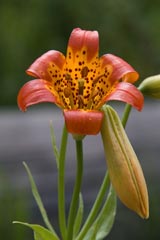
Sierra Tiger Lily |
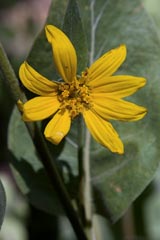
Mule's Ears |
I meandered back to the Middle Sunrise Lake for lunch, skirted its western shore to find a place to relax. The lake hosted a couple of small islands, the bigger was occupied by a group of kids having a wild High Sierra time. I settled back to enjoy lunch. While relaxing, I watched thunder clouds grow to the east, I heard several rumbles from a long distance, so I suspected the evening might be wet.
By 2:20 I had returned to Sunrise Camp. I took a hot shower, took a nap while the tent was still empty, and then cracked open my book. All the while the clouds kept building and distance claps of thunder could be heard. It was near 4:00 when a very light rain fell, fortunately it was short lived. It cleared locally, but the clouds hung over the canyons to the east. The evening was working towards a great sunset, the clouds imparting a sky of texture and color.
Around 5:30 my tent was populated with a group of three ladies who were part of a Ranger/Naturalist led group of eleven, and a father with two young sons, the two sons sharing one bed. The kids seemed to be really enjoying themselves, apparently dad carried the lion's share of the burden.
It turned out that I would be following the Ranger and eleven ladies for the remainder of my outing. What luck, the Ranger gave fireside chats each night, always educational and interesting. Besides, it was nice to compare stories of the day's outing with familiar faces.
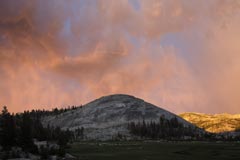
Sunset at Sunrise |
That evening's dinner was my favorite, baked salmon prepared just right. It came with all the usual High Sierra Camp fixings of soup, salad, bread, vegetables, and desert. That night the staff got a raving standing ovation. But oddly when I asked one of the boys if he enjoyed dinner, he said "It was great, they made me a special peanut butter and jelly sandwich."
As hoped for, sunset was a brilliant display of fiery hues of red clouds against darkening skies. Everyone enjoyed the show. I learned the next day when I reached Merced Camp that there was quite a storm at Vogelsang that night. Rumor had it that no one got any sleep for about three hours as the storm passed through. At Sunrise Camp, I had a great sleep, waking at one point to the light pitter patter of rain. Morning brought slight overcast but otherwise little threat.
Merced Camp via Echo Creek, Thursday, July 23
Another excellent breakfast. By 8:30 I was packed and ready to head out to Merced Camp. Of the two routes, one along the John Muir Trail (about 10.5 miles) and the other along Echo Creek (about 10 miles). I chose the latter, it seemed to be the preferred route.
In retrospect it was an excellent choice, the day turned out to be one of my two favorites. The outing started by backtracking 0.9 mile to the trail junction (8:51) leading over a short pass (gaining about 200 feet) to the drainage of Echo Creek. The remainder of the day was downhill, dropping 2500 feet to Echo Valley and then climbing a tiny 200 feet to Merced Lake and Camp (another 9.1 miles).
| |
|
What impressed me were the multiple meadows blooming with wildflowers. There were a wide variety of blooms, and yet there were also a wide variety that would soon bloom in the coming weeks. Unlike the previous days, I met very few others. This, of course, was not unexpected as I have often observed lightly peopled interiors. But for the few it was special.
Other than people, I met on the trail (or more correctly crossing the trail) a rattle snake, about six feet long. It was a great sighting, it just slithered onward across the trail and into the bush. I watched at a distance until it disappeared. Never heard a peep or a rattle!
At 11:18 I reached the first of two footbridges across Echo Creek. Shortly thereafter (11:35) I came upon the perfect lunch locale, a locale of cascading water, a place I highly recommend. On the map, it is almost exactly halfway between the two footbridges along Echo Creek, where the trail makes an "S" turn, where on the downhill side of the "S" the trail deviates from the creek. Some easy scrambling led me to a shade tree with awesome views of cascading Echo Creek. Remarkably there were no bugs, halleluiah! The spot is identified as A Great Lunch in the section on Directions & GPS Locations.
After lunch (12:30) I sauntered onward. At 1:20 I reached the trail junction to Echo Valley (my path) while the other direction led to Little Yosemite Valley / Half Dome / et. al. The marker indicated I had 3 more miles to go and had completed 7.
Another 0.7 mile brought me to Echo Valley and another trail junction. The assorted wildflowers in that short segment were wonderful. But it was the perfume that took me away, sweet and cunning and seductive and wildly devilish. The marvelous fragrance came from Western Azaleas, in the glory of full bloom.

Merced Lake |
The remaining 2.3 miles followed the Merced River, past Merced Lake, and then to Merced Camp. I reached my home for the next two days at 3:05.
Merced Camp sits adjacent to the Merced River, slightly east of the lake. The Camp accommodates 60 in tent cabins that sleep 4. It too has toilets, hot showers, and an improved laundry room to rinse out those accumulating aromatics. I am told it was once a boy scout hideaway, but that is long since history. I checked in, and was assigned a cabin with just two others.
Unlike the other camps I visited, Merced Camp is often a destination for longer stays. One family I chatted with was vacationing for a whole month. They hired mules to haul in all sorts of luxuries, such as a hammock and several inflatable kayaks. What a way to escape!
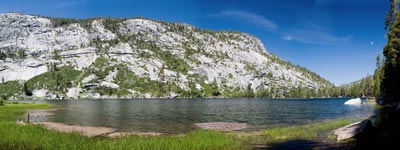
Walsh Lake |
It was nice getting into camp early, it gave me plenty of time to take another hot shower and relax. And that's what I did, the campfire area in the center of camp was a great place to sit, relax, and read a book.
Dinner that evening was another good meal. The main course was pulled pork, served fajita style. It was accompanied by the usual soup, great salad, fresh bread, fajita sides such as beans and rice, fresh vegetables, and desert. After dinner there was a Ranger talk by the campfire.
Exploring Merced, Friday, July 24
No doubt there are abundant nearby activities at Merced Camp. Swimming in the lake, surfing down the rapids, hiking to various places, kicking back to read a book, or just swatting mosquitoes at dusk and dawn. I chose to saunter up the Merced River toward Washburn Lake. Along the way were wildflowers, a couple of waterfalls, and of course the roaring Merced River. The more interesting of the two waterfalls was at a pool 1/4 mile beyond Walsh Lake.
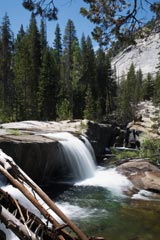
Merced Waterfall |
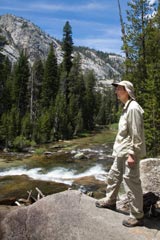
Taking It In |
It was a pleasant day, very relaxing, but it did not achieve a stellar grade. Mostly, Washburn Lake was too bog bound to be a great destination, lots of bugs - both mosquitoes and annoying black flies. The second waterfall was a fine place for lunch, it took a tiny bit of scrambling to find just the right perch for viewing (which also turned out to be a good spot to avoid the bugs). As always, I enjoyed the roaring Merced River. It was years earlier when I journeyed on my first solo backpack outing, it was through Little Yosemite Valley to the Bunnel Cascade, about 5 miles downstream from Merced Camp.
Early afternoon I returned to camp, relaxed, socialized by the campfire, read a book, took another hot shower, and relaxed some more until dinner time. I then met a guy who had been fishing the backcountry for almost two weeks, he happened to amble into Merced Camp and asked if he could buy a dinner. What a deal he got. For $29 he was given shower privileges (thank you very much) and dinner. We sat at the same table, he had many interesting stories of what I consider inaccessible lakes where he spent all his time at catch and release fishing. Well, he kept and cooked some of the trout, he didn't appear to have gone hungry.
Dinner that night was my second favorite, the main course was baked chicken. It was served with soup, another wonderful mixed green salad, garlic loaf bread, assorted fresh vegetables, and desert. The fishing/backpacking guy who bought the meal got his money's worth for he wasn't shy about asking for more. When the salad greens were all spoken for he asked for and the table received another bowl of salad. Likewise he did the same for the garlic loaf bread. No one went hungry, certainly not at my table. At the end of dinner, everyone gave the staff a standing ovation.
That evening I joined everyone else at the campfire for another Ranger talk. It was a stroke of luck that I should be following a Ranger led group, indeed I enjoyed all the cast-off amenities.
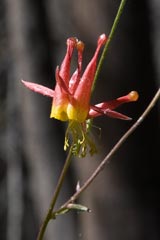
Western Columbine |
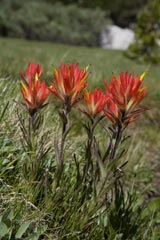
Scarlet Paintbrush |
Vogelsang Camp via Fletcher Creek, Saturday, July 25
I endured a bit of trepidation before the climb to Vogelsang Camp. Although the distance was a tolerable 7.6 miles, the 3000 feet of elevation gain was a concern especially with the initial steep cobblestone switchbacks. So I got an early start (8:17) when the weather was still cool. At 8:33 I reached the trail junction (7444') near the Ranger Station, the distance to Vogelsang was marked as 6.8 miles.
No doubt the uphill along the cobblestones was slow, but the early start not only meant the temperature was mild, but it also meant that much of the steep uphill would be in morning shade. At 9:22 I reached the next trail junction (8158'), one path following Fletcher Creek and the other following Lewis Creek over Vogelsang Pass. I chose Fletcher Creek, it being slightly shorter with less elevation gain.
In retrospect the Fletcher Creek route was a grand decision for this was by far the most scenic day of my outing. Someday I will have to compare notes after I trek along Lewis Creek.
Very shortly after the trail junction and a tiny bit of elevation loss I crossed a footbridge over roaring Fletcher Creek. From here I ascertained that the morning shade was history, also history was the worst of the uphill, but only the worst. My body complained with pouring sweat. So as I passed springs, I dipped my hat for the cool comfort of cold water. Ah, that felt good!
At 10:00 I was still climbing the cobblestone switchbacks, there was but tiny bits of shade. By 10:20 I had consumed much of my water so I refilled at a creek crossing and at the same time wet my head again in relief.
I reached the junction (8885') to Babcock Lake at 10:50. From here the difficult switchbacks were behind me, while ahead I would learn were two long expanses of scenic meadowlands. Babcock Lake demarked the first meadow, while the second and more expansive began near the creek outflow from Emeric Lake, slightly beyond the first and 500 feet higher via a tolerable set of switchbacks.
| |
|
It was my plan to take the short (0.3 mile) side trip to Babcock lake, but the diversion soon had a ford over Fletcher Creek. Although a simple ford, I didn't desire to change footwear to water shoes, so I left the diversion for another time.
Back at the Babcock Lake trail junction, the marker indicated 4.2 miles to Vogelsang. Soon afterwards (11:00) I felt pangs of hunger and I found a nice spot along now rushing, rather than roaring, Fletcher Creek to break for an early lunch. It was a short break (11:30), time enough to reenergize and to again refill my depleting water.
The landscape between the junction to Babcock Lake and Vogelsang was heaven on earth. Fletcher Creek was the mastermind on the landscape, feeding life giving water to the expansive meadows tucked into and dominated by soaring granite. Even the skies knew of this impressive place, as they too were influenced by the water in the meadows and the landscape of the granite to give way to striations and clusters of clouds against a backdrop of deep blue.
I rambled through this paradise reaching the ford across Fletcher Creek (12:30). The crossing was not difficult, there were ample rocks marking the path, but certainly the third leg of my walking staff was invaluable. Just after the creek crossing was the junction to Emeric Lake, it indicated another 2.2 miles to Vogelsang.
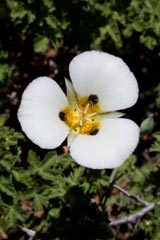
Mariposa Lily |
I followed Fletcher Creek upward, now just a child of its former roaring manhood. But children do play, and the creek amused the terrain. Along the way I caught a glimpse of a small waterfall, it was outflow from high above Vogelsang Lake feeding Fletcher Creek. The area was home to one of my favorite wildflowers, the Mariposa Lily. I had observed these throughout the High Sierra, but here they were thriving.
By 2:00 I reached Vogelsang Camp, the highest (10300') of the five High Sierra camps. The Camp accommodates 42 in tent cabins that sleep either 2 or 4. It had composting toilets and unlike the other camps I visited had no showers. Many of the tents were located within a child's stone's throw of meandering Fletcher Creek. I was one of the lucky ones, assigned a tent of two adjacent to the creek.
Although no formal showers, I did wash the salty sweat from my body and changed shirts. I also relaxed a bit in the dining tent drinking lemonade and munching on a slice of Vogelsang made gingerbread cake.
| |
|
My intentions for the remaining afternoon were to do some serious scouting, but the splendor of the land tamed my desires and I only meandered as far as Fletcher Lake, a few hundred yards away. The lake was fodder for other like minded enthusiasts, and in the nearby meadow several groups set up backpacking camps - certainly a prized destination.
Dinner that evening was steak burritos along with the usual soup, great salad, fresh bread, assorted vegetables, and desert. After dinner the Ranger/Naturalist whose group I had been following gave a first-rate lecture on astronomy, pointing out the names of the constellations in the night sky. Now if I could only remember!
It turned out that July 25th is a very special day for the High Sierra Camp staff. On this day every year, a party is held (in honor of what I believe is someone's birthday) at Merced Camp in the evening. So if you're young and fit (as is the staff), then after dinner on the 25th you hoof it down to Merced Camp for an evening of revelry. On this particular 25th, there was but a sliver of moon which set at 9:30PM, so I assumed headlamps were in order. Personally, I can't imagine such an endeavor, but much of our staff tramped the 7.6 miles and 3000 feet of elevation to Merced, partied, and then returned by 5AM to prepare breakfast. All the guests at breakfast cheered their endeavor.
Tuolumne Meadows via Rafferty Creek, Sunday, July 26
Sadly this was my day out. At 9:00 I departed for an uneventful walk. The landscape was so special the day before that nearly nothing could have made the otherwise pleasant walk anything but ho-hum. I plodded alongside Rafferty Creek, but unlike the dazzling terrain along Fletcher Creek from the day before or along Echo Creek from a few days previous, the terrain was by comparison bland. At 12:15 I was back at my car.
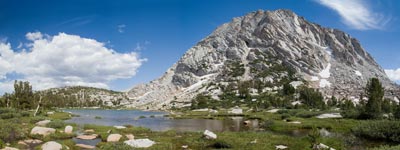
Fletcher Lake |
I did a quick scrub to remove the morning sweat, changed clothes, and headed for the Tuolumne Meadows convenience store. There I purchased a well deserved ice-cream.
It was a rude awakening immersing myself into the widely peopled Tuolumne Meadows. But all looked to be enjoying themselves, so who am I to complain. I was ready to drive home, I was ready for a well deserved lunch at my favorite Mexican restaurant in Groveland.
What I Learned for Next Time
Starting Out: With the best of the High Sierra within its interior, next time I would chose the shortest route to Sunrise Camp as I did on my exit from Vogelsang Camp. I would use the free shuttle system in Tuolumne Meadows for transport to either the Cathedral Lakes trailhead (8 miles to Sunrise), or better yet to the Tenaya Lake trailhead (6 miles to Sunrise).
Lunches: At $15 for a meager sack lunch, next time I would bring my own lunch materials. I like peanut butter, it doesn't require refrigeration, and tortillas are a great bread to make a sandwich. I would bring my favorite snacks such as GORP and mixed nuts and M&Ms. If I had the urge, I would buy a fresh fruit at one of the camps.
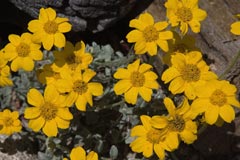
Woolly Sunflower |
Meals Only: I met two groups who backpacked the High Sierra and stayed near the camps for purchased meals. Dinner and a shower at Merced cost one backpacker $29, I would expect breakfast would be slightly less. Not only does this mitigate cost ($160 per night for tent & meals), but it also adds flexibility to when and how long you can go. I though of various hybrid trips where I would visit some of my favorite out of the way locales and also coordinate the trip near a Camp for meals and a shower.
Directions & GPS Locations
The table below identifies directions and GPS locations (NAD27 datum) of my High Sierra route. The time column marks the speed of my journey, although I sometimes stopped to play photographer so your time may be different.
|
Category |
GPS |
Alt |
Time |
Description |
Real Meals in Groveland |
|
|
Anytime |
Throughout much of the Sierras is a family owned chain of authentic Mexican food called Cocina Michoacana. Although my favorite one is in Groveland, they also have outlets in Oakdale and Sonora, and according to the web also Eureka. The address in Groveland is 18730 State Hwy 120 in the center of the small town. The Oakdale location is in the shopping center (1449 East F St.) next to Rite-Aid near the ARCO station. The one in Sonora is at 13955 Mono Way, south side of the street and just east of the Burger King. |
Tuolumne Meadows |
11S0294747 |
8759 |
7/21 |
From the parking lot of Tuolumne Meadows Lodge, the trail starts at its southwestern corner, adjacent to the employee's tent cabins. Follow this trail south with the employee's tent cabins on your left. You will shortly cross a footbridge to reach an east-west day-use trail, go east. After a few steps you reach a junction, take this trail south. About 0.6 mile further you reach the Lyell Fork of the Tuolumne River and a pair of footbridges. Cross these continuing on the southbound trail (avoiding the urge to walk on the day-use trails near the river. Another 0.1 mile brings you to the next formal trail junction. |
11S0294812 |
8733 |
7/21 |
Just south of footbridge from Lyell Fork of the Tuolumne River along the John Muir Trail and PCT. |
|
11S0292859 |
8644 |
7/21 |
Elizabeth Lake junction along the John Muir Trail. |
|
11S0290408 |
8579 |
7/21 |
Southwestern continuation of John Muir Trail towards Cathedral Lakes near Tuolumne Meadows. |
|
11S0287611 |
9439 |
7/21 |
Upper/Lower Cathedral Lakes junction. |
|
11S0287751 |
9720 |
7/21 |
Cathedral Pass, a place to enjoy the views. |
|
11S0286131 |
9373 |
7/21 |
Junction with John Muir Trail to Echo Creek drainage Trail to Merced Camp. |
|
11S0285826 |
9329 |
7/21 |
Sunrise Camp. |
|
Sunrise Camp to |
11S0285826 |
9329 |
7/23 |
Sunrise Camp. |
11S0286131 |
9373 |
7/23 |
Junction with John Muir Trail to Echo Creek drainage Trail to Merced Camp. |
|
11S0286289 |
7976 |
7/23 |
A great lunch spot, halfway between two Echo Creek footbridges near "S" bend. Nice roaring cascade. |
|
11S0284999 |
7442 |
7/23 |
Junction joining Echo Creek & east/west routes to downhill switchbacks to Echo Valley. |
|
11S0285420 |
7154 |
7:23 |
Junction at bottom of switchbacks in Echo Valley. |
|
11S0288042 |
7246 |
7/23 |
Merced Camp. |
|
Merced Camp to |
11S0288042 |
7246 |
7/25 |
Merced Camp. |
11S0289020 |
7444 |
7/25 |
Junction near Merced Camp Ranger Station. |
|
11S0289707 |
8158 |
7/25 |
Junction of Fletcher Creek & Lewis Creek Trails after climbing switchback cobblestones from Merced. |
|
11S0289570 |
8885 |
7/25 |
Junction along Fletcher Creek Trail to Babcock Lake. |
|
11S0290824 |
9406 |
7/25 |
Junction along Fletcher Creek Trail to Emeric Lake. |
|
11S0293538 |
10141 |
7/25 |
Vogelsang Camp. |
|
Vogelsang Camp to |
11S0293538 |
10141 |
7/26 |
Vogelsang Camp. |
11S0293997 |
9992 |
7/26 |
Junction at Tuolumne Pass (to Boothe Lake). |
|
11S0295741 |
8725 |
7/26 |
Junction at Rafferty Creek & John Muir Trail (at Lyell Fork of the Tuolumne River). |
|
11S0294812 |
8733 |
7/26 |
Just south of footbridge from Lyell Fork of the Tuolumne River along the John Muir Trail and PCT. |
|
11S0294747 |
8759 |
7/26 |
Trailhead at parking lot of Tuolumne Meadows Lodge. |
|
11S0294400 |
8706 |
7/26 |
My car parked in the Dog Lake trailhead parking lot. |





